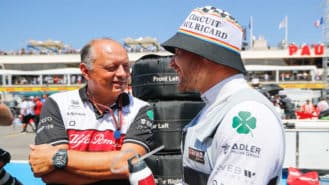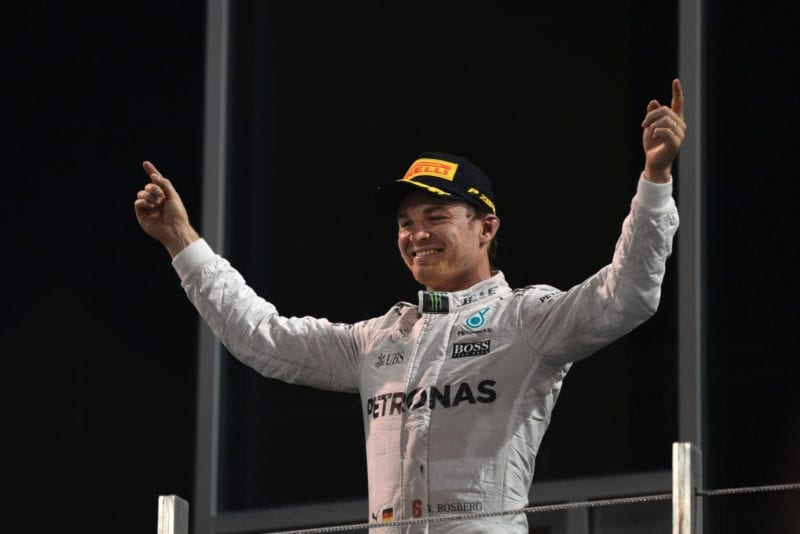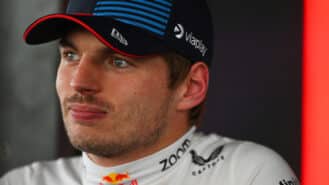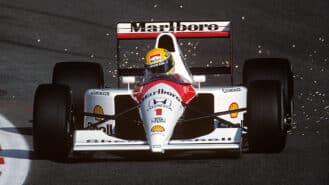
Bottas on Sauber's F1 downfall: 'When Vasseur left, it all fell to pieces'
Since the departure of team principal Fred Vasseur, Sauber's Formula 1 team has crumbled — leaving Valtteri Bottas to struggle for a return to the front of the grid

Grand Prix Photo
So we came to where the championship mathematics had put them after 20 races. Nico Rosberg vs Lewis Hamilton, and the maths said the only way the latter could take the title was to simultaneously win the race and compromise Rosberg’s enough to demote him from second to fourth. Hamilton could have chosen not to do that, of course, could’ve proved his point by disappearing into the distance and damn what the points said. But it’s the world championship and Hamilton, as even his dad has pointed out before, is a mercenary.
It’s a team sport. But only up to a point. Here we saw the fault line between a team’s interests and the driver’s, a line that Lewis has tread many times through his career. He drove whole swathes of the race between 1.5-2sec slower than he could have, so as to give the Red Bulls or Ferraris a chance of attacking Rosberg. But in a way that made it impossible for Rosberg to pass him. Pointedly instructed to up the pace, even by team boss Paddy Lowe, Hamilton responded with: “I suggest you just let us race.”
“You can understand the team’s perspective and can understand Lewis’,” said the new world champion Nico Rosberg. “Lewis was using all his skill to do it perfectly so there was absolutely no chance to get by him.” Rosberg said this emotionally drained, appearing to be working hard not to release it all with a flood of tears. Somehow the menace never did materialise, the flash of red or blue/yellow never appeared in his periphery. But it was in doubt virtually to the end. “That out there was not a nice experience and I hope I don’t experience it again any time soon. Pressure from behind, Lewis driving slow in front. It was so intense, with those two guys behind, knowing if I dropped behind them it was over.”
If that had happened it would’ve been even worse than Austin last year, when he’d almost won, which would at least have delayed Hamilton’s title for another race. But he’d let it slip from his hands. “Austin ‘15 was a horrible experience and I said to myself I didn’t ever want to go through that again.” That feeling multiplied was the threat hanging over him in the overheated emotions he managed somehow to control.
He broke no rules, but were Hamilton’s tactics fair? “I was fighting for a championship, leading the race, so I control the pace.”
“I’m conflicted,” admitted Toto Wolff. “We instructed him to up the pace because there were two occasions when it looked like we could lose the race. With Max Verstappen early in the race and Sebastian Vettel later. But he did not comply. There is no room for anarchy in a team… On the other hand this was the only way he could have won the world championship. Maybe you just can’t have someone that is such a bulldog of a driver who will also comply in every situation.”
On yet another hand, one ex-driver pointed out that Hamilton wasn’t as savage as he could have been, that he only did half the job. Whatever, it’s a big boy’s game and Nico Rosberg has finally won it. “I feel like I’ve been racing him for ever and always he’s just edged me out, even when we were kids,” he said. “That makes this so much more satisfying, that I took the world championship away from him.”
There was no disguising Rosberg’s disappointment after qualifying second, a quarter of a second slower than Hamilton‘s pole time. Amid all the talk of race day and whether Hamilton would try to back Rosberg into the Red Bulls etc, the best way for Rosberg to levitate himself above such grubby concerns would’ve been to have set pole and disappear into the distance on Sunday – and through the practices there looked little between the two Mercs. Nico was regularly slightly faster through the sweeps of the first sector, Hamilton ahead on the tight twists of sector three, happy with the change he made in Brembo brake material. There was an inverse link between your performance in the two sectors generally, according to how much you took from the ultra-soft tyres early in the lap. Whether you pushed hard early, like Nico, or saved some for later, like Lewis, seemed like just two different ways of doing the same lap time.
But when it mattered, Hamilton revealed he had more in hand through that final sector – and Rosberg had no answer to him. “I came here to try to be on pole,” he recounted, “but it just wasn’t possible for me to do that time [of Hamilton’s] even though I gave it everything.”
So was Hamilton’s 61st pole set and Daniel Ricciardo in the best non-Mercedes was 0.9sec slower. He’d been struggling a little relative to his team-mate but gradually finessed a better set-up and produced a tidy lap at his final attempt. Both Red Bulls did their Q2 laps on the super-soft rather than the ultra, the idea being to give them a longer first stint of the race. Max Verstappen was on course to have comfortably beaten Ricciardo’s Q3 time before locking up over the tricky bump in the braking area of turn 11, having also suffered a moment there on his previous run. Forced to abandon the last lap, his earlier effort was good only for sixth, with the two Ferraris nestling between the Red Bulls.
Kimi Räikkönen was again slightly faster than Sebastian Vettel, Kimi’s educated guess on set-up as the track temperatures cooled turning out to be better than Vettel’s which was, as Seb put it, “A bit too aggressive.” This was a reflection of the Ferrari’s narrow window into its temperature-sensitive sweet spot at a place where practice at three in the afternoon is always a whole lot hotter than qualifying in the desert dusk. Vettel ended up 0.06sec slower, also claiming to have been distracted by Verstappen’s turn 11 lock-up.
The Force Indias were only around 0.3sec adrift of Red Bull and Ferrari, allowing Nico Hülkenberg and Sergio Pérez to go sixth and seventh respectively with no particular problems. This was a good recovery from Hulk after missing all of P1 (when his car was handled by third driver Alfonso Celis) and much of P3 (to a technical problem).
Fernando Alonso got the McLaren-Honda into Q3. Low 1m 41.0sec seemed to be the car’s limit – for it’s what he did in Q1, 2 and 3 and what Jenson Button did in Q1. In Q2 the cooling conditions gave the car a little more understeer and Button had run out of set-up options to banish that, leaving him that crucial bit slower and back in 12th on what he was making plain was actually his final Grand Prix.
Also in his final Grand Prix, Felipe Massa got through to Q3, his the only Williams to do so. He couldn’t, however, come close to equalling his Q2 lap once there and so would start 10th. Valtteri Bottas, out-qualified by Massa for only the fourth time this season, could find no extra grip from the ultra-soft compared to the super-soft and was back in 11th.
At Haas Esteban Gutiérrez did a better job than Romain Grosjean in anticipating the set-up implications of the cooling track and they qualified 13th and 14th respectively, around 0.5sec away from the Q3 cut-off. A couple of tenths back from there Jolyon Palmer was again the only Renault driver to make Q2, 0.4sec and three places ahead of Kevin Magnussen, while Pascal Wehrlein did a great job to get his Manor into Q2 for the fifth time this season and would line up 16th. Just like Bottas, Esteban Ocon in the other Manor could not get the ultra-soft working and was back in 20th 0.4sec off his team-mate.
Toro Rosso had a nightmare repeat of their wheelrim problems from Austin, having to abandon second practice altogether as it investigated why Daniil Kvyat had suffered two left-rear punctures. It left both cars bereft of valuable track time and the removal of the pieces doing the damage cost around 15 points of downforce and they failed to clear Q1, Kvyat and Carlos Sainz (with an under-performing engine in addition) back in 17th and 21st respectively. Felipe Nasr in 19 reversed the recent trend at Sauber to out-qualify Marcus Ericsson who lined up at the back.
Hamilton’s odds of winning this title looked longer than the shadows as he and Rosberg sat on the dusk grid. Latent tension up front there, poignant greetings further back for Massa and Button who gave each other a hug. Inside the car, the emotion in the eyes behind Jenson’s helmet was visible. Standing to the side of the McLaren, his mum. Missing from the happy picture, his dad, three years gone. His absence hung heavy.
Neither veteran would have great final races. Button would pull in after taking too much of an inner kerb, breaking a front suspension link. Massa brought the Williams home ninth. Thirty two seasons of F1 experience between them, they were rendered a sideshow as soon as the lights went out.
Hamilton clean away from Rosberg. Strike one opportunity for Rosberg; he could no longer grasp the destiny of this race by the collar. Räikkönen next, resolute in defending from Ricciardo who locked up heavily into turn one, big flat spots for the rest of his stint, cutting in ahead of Vettel as they exited the turn. Verstappen slow off the startline, side-by-side with Hülkenberg through turn one, running out wide, right front hitting the Force India’s sidepod, spinning the Red Bull to the back. It was the best thing that could’ve happened to him – though doubtless it didn’t feel like that at this moment.
Even with Hamilton soon controlling the pace very tightly, Mercedes, Ferrari and Red Bull remained in a separate race to the rest, which were led almost throughout by the dicing Force Indias – Hulk with the upper hand over Pérez – not far clear of Massa and Alonso’s McLaren. They too were barely noticed as the Hamilton-Rosberg drama played out.
Hamilton was playing his ruse pretty much immediately. He would cruise the twisty sector three, where there are no passing places, waiting an age to get on the power out of the slow corners, then attack the final couple of turns to pull himself out of Rosberg’s reach, staying fast through turns 1-4, the high-speed aero corners, his wake disrupting Rosberg’s car. Getting hard and good on the power out of turn seven onto the back straight, out of DRS reach, and again out of the chicane to stay ahead in the second DRS zone. Returning him to the final sector.
At Mercedes they’d half expected this – and had planned around it. There were two different compounds of tyres waiting in the pitlane for each car, just in case Hamilton decided he was going to do his own strategy. They could respond accordingly.
Hamilton had to not overplay it, not go so slowly that Rosberg could simply overtake. But in the first stint of this two–stop race, Räikkönen in third could never quite take advantage. The slow pace set by Lewis meant the quicker cars were on the verge of allowing their front tyres to fall below their temperature window – which invariably induces graining – and the Ferrari is always the most susceptible to this, and was again here. Ricciardo, with his flat spots, was struggling – as was Vettel in fifth, also with the Ferrari’s front tyres.
Verstappen by the sixth lap had made it halfway up the field and the slow pace at the front meant he was just 22sec off the lead – on super-softs, with most of the ultra-shod cars between him and the leaders about to pit out his way. Hamilton was brought in next lap and exited just ahead of him. Rosberg came in a lap later and exited just behind the Red Bull. Both Mercedes releases were delayed for Ferraris coming into their boxes just as the Mercs were trying to leave. This had determined Rosberg not getting out in front of Verstappen – which was potentially a serious complication for his race. Max was running a seriously good pace and the super-softs were not graining – much to Merc’s surprise. By around the 10th lap it dawned on Mercedes that at this rate Max was potentially going to be able to one-stop.
Ricciardo was brought in from a temporary lead on the eighth lap and exited still fifth, between the Ferraris of Räikkönen and Vettel. Hamilton now led from Verstappen and Rosberg.
Lap after lap passed and still Verstappen was able to comfortably make the tyres last at the gentle pace Hamilton was setting and so it became ever-more certain he’d be one-stopping and as such he was now a threat for victory. Rosberg was informed he’d need to pass him on the road – probably not the most welcome news to him.
He finally did it with a beautiful move up to and through the chicane of 8-9 and down the following straight to the left of 11, marshalling his DRS and energy deployment and ignoring Verstappen’s strong defence. Now he was right back on his team-mate’s tail. “Up the pace,” Lewis was instructed, the team anxious about Verstappen. Not going to happen, decided Hamilton.
That spin of Verstappen’s meant there was no undercut pressure that he would otherwise have been subject to, had he been running with the Ferraris. So he could stay out and get the full strategic advantage of his more durable tyres and not even get left behind as they became old – as Hamilton was compressing the field. Bizarrely, his spin cost him less time than the better strategy it allowed gained him. He made his one and only stop on lap 21, this undercutting him past Ricciardo when the latter made his second stop three laps later, though Daniel in turn undercut himself ahead of Räikkönen. Ferrari tried to respond with Kimi next lap, but it was a doomed attempt.
Vettel – having been at the back of the lead group up to the second stops – was also not prone to any undercut pressure, so could run way longer than the Mercs, Räikkönen and Ricciardo. Long enough to enjoy nine laps in clear air in the lead, this in turn enough to give him a short enough final stint he could get onto the super-softs when everyone else had to be on the much slower softs.
Hamilton could only work with the information he had. In hindsight, once Rosberg had got past Verstappen, Hamilton did not slow the pace enough. Had he backed off just a little more before his second stop on lap 28, there would not have been enough of a gap to bring Rosberg in on the next lap and get out still ahead of Verstappen. Then again, he’d been warned by the team before the race that if he was backing Rosberg into being undercut, Nico would be given pitstop priority. That would of course have jumped him past Hamilton.
Vettel stayed out until lap 37, came in, had his super-softs fitted and began to fly. Well, relative to the pace Hamilton was setting, that is. Still Lewis continued frying Rosberg’s brain with his deliberately disruptive driving. The saving grace for Rosberg was he could use the DRS from Hamilton to keep himself out of Verstappen’s reach.
Vettel rejoined sixth, but only 17sec behind the leader, and lapping between 1.5-2sec faster with 18 laps to go. Now he was the threat to a Mercedes victory – and Hamilton was urged again to increase his pace, this time by Paddy Lowe. Again the request was declined. Surely Vettel was not a realistic threat to victory? If he’d found a way by Rosberg, would not Hamilton then have had the performance to stay ahead of the Ferrari? Not if his older, harder tyres were under-temperature and graining from being driven so slowly. The Merc strategy software was predicting a Vettel victory at this point.
Vettel was given a free passage by team-mate Räikkönen and picked off Ricciardo up to turn 11 with nine laps to go. Next: Verstappen, on harder tyres 16 laps older. He passed him with four laps to go at the same place, again with the help of DRS. Could he get Rosberg too? He would just fall short. “The problem when you have been passing car after car you begin to slide, so my tyres got worse. When I was behind Nico I was faster – but also due to the fact that Lewis was slowing down. I think he must’ve had a problem!” This latter point was made with a big grin. “I tried everything but they were very, very quick down the straights. I couldn’t try anything really stupid like a really late dive because Lewis was so close ahead and I’d have risked hitting Lewis trying to pass Nico. Also Max was right in my mirrors so I had to watch him too. It was intense.”
Rosberg concurred. The emotional power as the stress was released into disbelieving celebration was visible and sincere. As they got out the cars in the collecting area Hamilton went to shake his hand. Rosberg accepted it but the eyes sent Hamilton the appropriate message. Later on Keke made a rare appearance. Thirty four years after his own title celebration in Las Vegas, now it was Nico Rosberg, world champion. Hamilton cancelled his media briefing and headed off into the night.

Since the departure of team principal Fred Vasseur, Sauber's Formula 1 team has crumbled — leaving Valtteri Bottas to struggle for a return to the front of the grid

Max Verstappen drove Lando Norris off the road in the past two GPs and did the same to Lewis Hamilton in 2021. It's an effective tactic, even when penalised, says Mark Hughes. So F1 stewards need tougher sanctions

Picture the scene. You're in the depths of a Sao Paulo nightclub, surrounded by hundreds, when suddenly you're transported back through F1 history as the voice of Ayrton Senna begins…

Ayrton Senna won the 1991 F1 championship with McLaren's MP4/6, the only V12 car to win the title. Team members tell James Elson of the chaotic efforts to defeat the superior Williams — a fight where Senna made the difference